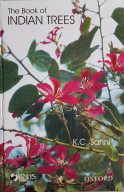
We depend on plants and trees for our survival - for food, clothing, shelter, furniture etc. UN Conference on Environment, held in Stockholm in 1972 marked the beginning of serious discussion about the importance of trees. The subject was discussed at length at the Rio de Janeiro Un Conference on Environment, held twenty years after the Stockholm Conference. In view of the ecological imperatives such as the urgent need to control pollution and avert global warming, the great value of trees should be understood by all.
Thus, there is a need to provide information to common people about the importance trees. This book published by BNHS and Oxford Printing Press fulfils the said need. The fact that the book is reprinted every year since 2013 strengthens this statement.
The book is intended as a popular guide describing the characteristics and distribution of trees of the Indian subcontinent. It covers 7 countries of South Asia and Southeast Asia: India, Pakistan, Bangladesh, Nepal, Bhutan, Myanmar and Sri Lanka. The main purpose of this book is to provide a means for the layman to become acquainted with the main trees of our forests and thus foster and interest in forestry and natural history.
The choice of trees is confined to important, indigenous, conspicuous and interesting trees of natural history interest. For example, karayani (Cullenia exarillata) of the “Ghats” of Kerala which is the habitat of the lion-tailed macaque, upas tree (Antiaris toxicaria), the poisonous milky later of which is used for poisoning arrows for hunting, tiger tree (Bischofia javanica) the soft bark of which is favoured by tigers for cleaning claws and many such trees associated with animals and birds.
The book contains a detailed introduction (15 pages). In the introduction, a brief account of the forest vegetation, geography, climate and hints on identification are given. The information on 153 species includes the latest valid botanical name, with well known synonyms, popular name, vernacular names in use in the countries covered; etymology indicating how the botanical name is derived; a systematic and comprehensive botanical description; phonological data giving the months of leafing, flowering and fruiting to aid seed collection, details of distribution of trees, “spot characters” by which is meant the outstanding diagnostic characters of species for quick identification, uses and propagation.
To aid recognition of trees described in this book, seventeen coloured plates by renowned photo graphers and seventy line drawings and eleven silhouettes by P.N. Sharma, one of the leading botanical artists of our country.
Glossary of botanical terms, Index of botanical names and Index of common names given at the end have added to the utility of the book. It is lucidly written and certainly helps the common man to recognise the 153 trees easily.
